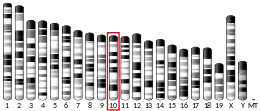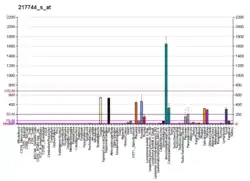| PERP | |||||||||||||||||||||||||||||||||||||||||||||||||||
|---|---|---|---|---|---|---|---|---|---|---|---|---|---|---|---|---|---|---|---|---|---|---|---|---|---|---|---|---|---|---|---|---|---|---|---|---|---|---|---|---|---|---|---|---|---|---|---|---|---|---|---|
| Identifiers | |||||||||||||||||||||||||||||||||||||||||||||||||||
| Aliases | PERP, KCP1, KRTCAP1, PIGPC1, THW, dJ496H19.1, TP53 apoptosis effector, p53 apoptosis effector related to PMP22, EKVP7, OLMS2 | ||||||||||||||||||||||||||||||||||||||||||||||||||
| External IDs | OMIM: 609301 MGI: 1929938 HomoloGene: 11098 GeneCards: PERP | ||||||||||||||||||||||||||||||||||||||||||||||||||
| |||||||||||||||||||||||||||||||||||||||||||||||||||
| |||||||||||||||||||||||||||||||||||||||||||||||||||
| |||||||||||||||||||||||||||||||||||||||||||||||||||
| |||||||||||||||||||||||||||||||||||||||||||||||||||
| Wikidata | |||||||||||||||||||||||||||||||||||||||||||||||||||
| |||||||||||||||||||||||||||||||||||||||||||||||||||
p53 apoptosis effector related to PMP-22 is a plasma membrane protein that, in humans, is encoded by the PERP gene.[5][6]
PERP is a direct transcriptional target of p53, but its transcription can also be regulated by other transcription factors.[7]
PERP is important for skin development, and loss of PERP is associated with the development and progression of several types of human cancers.[7]
References
- 1 2 3 GRCh38: Ensembl release 89: ENSG00000112378 - Ensembl, May 2017
- 1 2 3 GRCm38: Ensembl release 89: ENSMUSG00000019851 - Ensembl, May 2017
- ↑ "Human PubMed Reference:". National Center for Biotechnology Information, U.S. National Library of Medicine.
- ↑ "Mouse PubMed Reference:". National Center for Biotechnology Information, U.S. National Library of Medicine.
- ↑ Hildebrandt T, Preiherr J, Tarbe N, Klostermann S, Van Muijen GN, Weidle UH (Dec 2000). "Identification of THW, a putative new tumor suppressor gene". Anticancer Res. 20 (5A): 2801–2809. PMID 11062687.
- ↑ "Entrez Gene: PERP PERP, TP53 apoptosis effector".
- 1 2 Roberts O, Paraoan L (Dec 2020). "PERP-ing into diverse mechanisms of cancer pathogenesis: Regulation and role of the p53/p63 effector PERP". Biochim Biophys Acta Rev Cancer. 1874 (1): 188393. doi:10.1016/j.bbcan.2020.188393. PMID 32679166. S2CID 220631324.
Further reading
- Maruyama K, Sugano S (1994). "Oligo-capping: a simple method to replace the cap structure of eukaryotic mRNAs with oligoribonucleotides". Gene. 138 (1–2): 171–174. doi:10.1016/0378-1119(94)90802-8. PMID 8125298.
- Suzuki Y, Yoshitomo-Nakagawa K, Maruyama K, et al. (1997). "Construction and characterization of a full length-enriched and a 5'-end-enriched cDNA library". Gene. 200 (1–2): 149–156. doi:10.1016/S0378-1119(97)00411-3. PMID 9373149.
- Attardi LD, Reczek EE, Cosmas C, et al. (2000). "PERP, an apoptosis-associated target of p53, is a novel member of the PMP-22/gas3 family". Genes Dev. 14 (6): 704–718. doi:10.1101/gad.14.6.704. PMC 316461. PMID 10733530.
- Strausberg RL, Feingold EA, Grouse LH, et al. (2003). "Generation and initial analysis of more than 15,000 full-length human and mouse cDNA sequences". Proc. Natl. Acad. Sci. U.S.A. 99 (26): 16899–16903. Bibcode:2002PNAS...9916899M. doi:10.1073/pnas.242603899. PMC 139241. PMID 12477932.
- Bonkobara M, Das A, Takao J, et al. (2003). "Identification of novel genes for secreted and membrane-anchored proteins in human keratinocytes". Br. J. Dermatol. 148 (4): 654–664. doi:10.1046/j.1365-2133.2003.05244.x. PMID 12752121. S2CID 21635573.
- Mungall AJ, Palmer SA, Sims SK, et al. (2003). "The DNA sequence and analysis of human chromosome 6". Nature. 425 (6960): 805–811. Bibcode:2003Natur.425..805M. doi:10.1038/nature02055. PMID 14574404.
- Ota T, Suzuki Y, Nishikawa T, et al. (2004). "Complete sequencing and characterization of 21,243 full-length human cDNAs". Nat. Genet. 36 (1): 40–45. doi:10.1038/ng1285. PMID 14702039.
- Ihrie RA, Attardi LD (2004). "Perp-etrating p53-dependent apoptosis". Cell Cycle. 3 (3): 267–269. doi:10.4161/cc.3.3.722. PMID 14726658.
- Gerhard DS, Wagner L, Feingold EA, et al. (2004). "The status, quality, and expansion of the NIH full-length cDNA project: the Mammalian Gene Collection (MGC)". Genome Res. 14 (10B): 2121–2127. doi:10.1101/gr.2596504. PMC 528928. PMID 15489334.
- Otsuki T, Ota T, Nishikawa T, et al. (2007). "Signal sequence and keyword trap in silico for selection of full-length human cDNAs encoding secretion or membrane proteins from oligo-capped cDNA libraries". DNA Res. 12 (2): 117–126. doi:10.1093/dnares/12.2.117. PMID 16303743.
This article is issued from Wikipedia. The text is licensed under Creative Commons - Attribution - Sharealike. Additional terms may apply for the media files.




